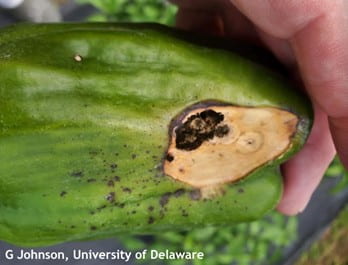Gordon Johnson, Extension Vegetable & Fruit Specialist; gcjohn@udel.edu
With the recent hot temperatures and more predicted, there is high potential for sunburn in fruits and fruiting vegetables. Growers may need to consider ways to protect against sunburn. Sunburn is most prevalent on days with high temperatures, clear skies and high light radiation. We commonly see sunburn in watermelons, tomatoes, peppers, eggplants, cucumbers, apples, strawberries, and brambles (raspberries and blackberries).
There are three types of sunburn which may have effects on the fruits. The first, sunburn necrosis, is where skin, peel, or fruit tissue dies on the sun exposed side of the fruit. Cell membrane integrity is lost in this type of sunburn and cells start leaking their contents. The critical fruit tissue temperature for sunburn necrosis varies with type of fruit. Research has shown that the fruit skin temperature threshold for sunburn necrosis is 100 to 104°F for cucumbers; 105 to 108°F for peppers, and 125 to 127°F for apples. Fruits with sunburn necrosis are not marketable. Injury may be white to brown in color.

Sunburn necrosis and photooxidative sunburn on pepper fruit. Note secondary disease infections on damaged tissue.
The second type of sunburn injury is sunburn browning. This sunburn does not cause tissue death but does cause loss of pigmentation resulting in a yellow, bronze, or brown spot on the sun exposed side of the fruit. Cells remain alive, cell membranes retain their integrity, cells do not leak, but pigments such as chlorophyll, carotenes, and xanthophylls are denatured or destroyed. This type of sunburn browning occurs at a temperature about 5°F lower than sunburn necrosis (i.e. 115 to 120°F in apples). Light is required for sunburn browning. Fruits may be marketable but will be a lower grade.
The third type of sunburn is photooxidative sunburn. This is where shaded fruit are suddenly exposed to sunlight as might occur with late pruning, after storms where leaf cover is suddenly lost, or when vines are turned in drive rows. In this type of sunburn, the fruits will become photobleached by the excess light because the fruit is not acclimatized to high light levels, and fruit tissue will die. This bleaching will occur at much lower fruit temperatures than the other types of sunburn. Damaged tissue is often white in color.
Recent storms have caused canopies in some vegetable crops to be more open, exposing fruits to a high risk of both sunburn necrosis and photooxidative sunburn.
Genetics also play a role in sunburn and some varieties are more susceptible to sunburn. Varieties with darker colored fruit, those with more open canopies, and those with more open fruit clusters have higher risk of sunburn. Some varieties have other genetic properties that predispose them to sunburn, for example, some blackberries are more susceptible to fruit damage from UV light.
Control of sunburn in fruits starts with developing good leaf cover in the canopy to shade the fruit. Fruits most susceptible to sunburn will be those that are most exposed, especially those that are not shaded in the afternoon. Anything that reduces canopy cover will increase sunburn, such as foliar diseases, wilting due to inadequate irrigation, and excessive or late pruning. Physiological leaf roll, common in some solanaceous crops such as tomato, can also increase sunburn.
In crops with large percentages of exposed fruits at risk of sunburn, fruits can be protected by artificial shading using shade cloth (10-30% shade). However, this is not practical for large acreages.
For sunburn protection at a field scale, use of film spray-on materials can reduce or eliminate sunburn. These materials are kaolin clay based, calcium carbonate (lime) based, or talc based and leave a white particle film on the fruit (such as Surround, Screen Duo, Purshade and many others). There are also film products that protect fruits from sunburn but do not leave a white residue, such as Raynox. Apply these materials at the manufacturer’s rates for sunburn protection. They may have to be reapplied after heavy rains or multiple overhead irrigation events.
While particle films have gained use in tree fruits, their usefulness in vegetables is still unclear. Research at UD and the University of Maryland has shown reduced fruit disorders such as sunburn in peppers and white tissue in tomatoes when applied over those crops. Watermelon growers have used clay and lime-based products for many years to reduce sunburn in that crop in southern states.
There are some drawbacks to the use of particle films. If used for sunburn protection on fruits, there is added cost to wash or brush the material off at harvest. Where overhead irrigation is used, or during rainy weather, the material can be partially washed off of plants, reducing effectiveness and requiring additional applications. Produce buyers can also have standards relating to the use or particle films and may not accept products with visible residues. For example, some watermelon brokers will accept watermelons where calcium carbonate protectants have been used but will not accept watermelons sprayed with clay-based products.
